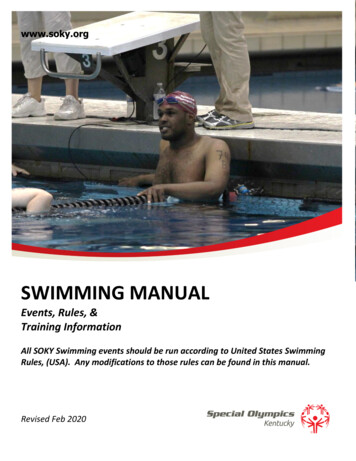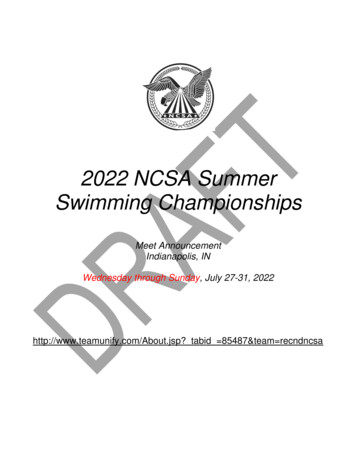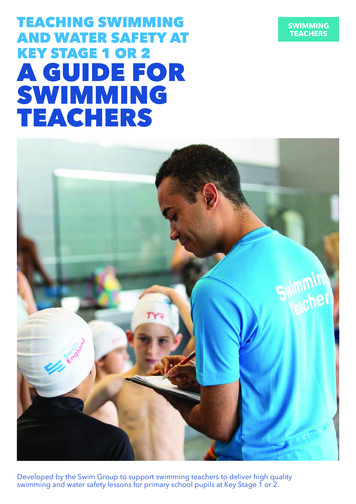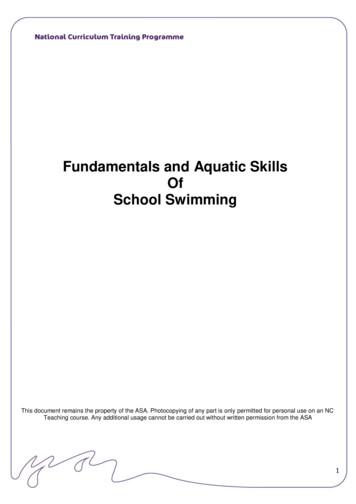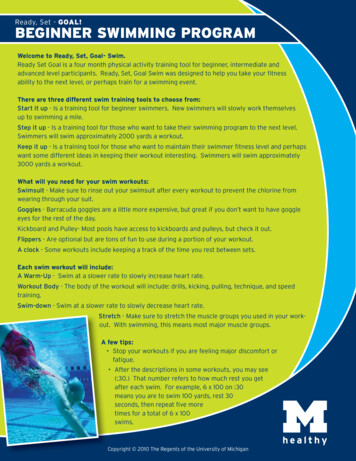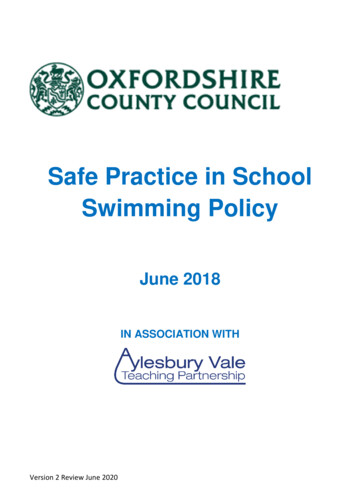
Transcription
Safe Practice in SchoolSwimming PolicyJune 2018IN ASSOCIATION WITHVersion 2 Review June 2020
Oxfordshire County Council in Association with Aylesbury Vale Teaching PartnershipHealth and Safety Policies and ProceduresSafe Practice in School Swimming Policy Revised Edition June 2018ForewordI would like to thank the following individuals for their contributions and support in updating thisrevised edition of the Oxfordshire Safe Practice in School Swimming Policy:Ali ArberAdviser for Physical Education, LEAPAllison HolleyAVTP Administrator for SwimmingAnn StevensPool Manager, Hagbourne Primary School & RLSS Trainer/AssessorAnnette MashruHeadteacher, St. Andrew’s CE Primary SchoolBeeba HeskinsGLL Assistant Commercial Product ManagerGeorgie BoddySwim Teacher & Licensed Swim England TutorJames WattDeputy Headteacher, Brookside Primary SchoolJean NoonanOxfordshire CC Schools’ Health & Safety ManagerKim DaviesSwimming Coordinator, Risborough SpringsMichael DunnDeputy Director of Education and Research - RLSS UKMike ShuffCarlton Associates LtdMiranda MoslinSwimming Coordinator, Stoke Mandeville StadiumNeil BaileyNeil Bailey SwimmingOllie BrewerDevelopment Coach at Wycombe District Swimming ClubRob LloydVale Safety TrainerSarah WrightAqua Vale, Everyone Active Swim Lesson ManagerSue BarnesOxfordshire CC Schools’ Health & Safety OfficerSue ParkerLicensed Swim England Swim TutorSusan BarlowSwim England Programme Manager Youth and CommunityTerry DayCountrywide Premises SupervisorWendy ZakrzewskiBetter, Sports Officer2
Oxfordshire County Council in Association with Aylesbury Vale Teaching PartnershipHealth and Safety Policies and ProceduresSafe Practice in School Swimming Policy Revised Edition June 2018References and full contact details can be found on pages 51 - 53.Jean NoonanSchools’ Health & Safety ManagerHealth and Safety TeamOxfordshire County Council3
Oxfordshire County Council in Association with Aylesbury Vale Teaching PartnershipHealth and Safety Policies and ProceduresSafe Practice in School Swimming Policy Revised Edition June 2018ContentsFor all involved with School Swimming – this can be found on the following websites: Oxfordshire County CouncilAylesbury Vale Teaching Partnership (recommended training providers)ContentsSummaryIntroductionGlossary of TermsDefinitionsResponsibilitiesNormal Operating Procedure (NOP)Emergency Action Plan (EAP)Risk AssessmentMedical InformationFirst aid ArrangementPool RulesSchool Staff Accompanying Pupils to School Swimming LessonsTeaching qualifications required for school staffCourse names and EquivalentsSchool Swimming Teaching ScenariosTeacher Pupil RatiosSwim England Teacher to Pupil Ratio GuidelinesSwim England GuidanceAfPE GuidanceLifeguarding Qualifications for School Swimming and Water SafetyLifeguarding QualificationsDiving - Shallow Entry Racing DivesTeaching Self-Rescue and Water SafetySchool Swimming GalasSwimmers with DisabilitiesSwimming Teacher PositionTeaching in the WaterSwimming Clothing and EquipmentGuidance on GogglesSafeguardingConditions of Hire to Outside OrganisationsSafety EquipmentSchool Pool ManagementEducational VisitsNatural Water Bathing/Open Water SwimmingReferencesFurther Advice and 526272930303132333434353636373840424245475153544
Oxfordshire County Council in Association with Aylesbury Vale Teaching PartnershipHealth and Safety Policies and ProceduresSafe Practice in School Swimming Policy Revised Edition June 2018SummaryThe purpose of this document is to set out the policies and provide guidance on Safe Practice in SchoolSwimming and Water Safety, whether at a school pool, hydrotherapy pool, public pool or during schoolvisits. It aims to keep everyone involved in School Swimming safe. Included are the policies andprocedures of Oxfordshire County Council (OCC) based on current national guidance in relation toSchool Swimming and Water Safety lessons, swimming pool safety, and educational visits, which mayinclude water-based activities.The appendices contain exemplar materials and greater detail on guidance.This policy is for all OCC maintained schools. It is recommended that Academies, Foundation andVoluntary Aided schools also follow the guidance within the policy.Where schools use Leisure Provider pools, partnership working is vital, not only to keep pupils andstaff safe, but also to ensure the inclusion of a breadth of aquatic opportunities, which meet the needs ofall pupils.5
Oxfordshire County Council in Association with Aylesbury Vale Teaching PartnershipHealth and Safety Policies and ProceduresSafe Practice in School Swimming Policy Revised Edition June 2018IntroductionThe following policy has been revised and updated by Aylesbury Vale Teaching Partnership forOxfordshire County Council. It has been through wide consultation involving Oxfordshire Headteachers,Leisure Providers across Bucks and Oxfordshire, Swimming Coordinators, the Bucks Swim FocusGroup, Swim England (formerly ASA) and Royal Lifesaving Society (RLSS), to provide a valuable andaccurately informed working document. It is intended to inform and support the following: Headteachers,Governors,Teachers in Charge of School Swimming and Water Safety within their school,Leisure Providers,Swimming Teachers.Working in partnership will ensure a consistent joined up approach in the planning and delivery of safe,quality School Swimming and Water Safety lessons.‘Swimming is a very inclusive, health-promoting activity that can be continued for life. Learning to swimand be confident in water not only saves lives but can also provide the essential foundation for individualsto access many water-based recreational activities. Aquatic activities include swimming, Water Safetyactivities, lifesaving, diving and open-water swimming.’ (AfPE Safe Practice in Physical Education,School Sport and Physical Activity 2016 Edition)‘Swimming in clothes differs considerably from styles and techniques used in normal swimming lessons.Students should be taught how to conserve energy and body heat through the use of gentle swimmingmovements and holding particular body positions. Wearing everyday clothing helps simulate realsituations.’(AfPE Safe Practice in Physical Education and School Sport and Physical Activity 2016 9th Edition)Physical Education including Swimming is a National Curriculum Foundation Subject and thusSTATUTORY.All schools must provide Swimming instruction in either Key Stage 1 and/or Key Stage 2. Inparticular, pupils should be taught to: Swim competently, confidently and proficiently over a distance of at least 25m, Use a range of strokes effectively, such as front crawl, backstroke and breaststroke, Perform safe self-rescue in different water-based situations.Swim England recommend that pupils will receive a minimum of 25 hours of School Swimmingand Water Safety before the end of Key Stage 2.Swimming is a highly beneficial life-saving activity. It supports the acquisition and development ofphysical literacy, along with skills for health and enjoyment. Swimming is ‘Wet Physical Education’.As a threshold skill, it also gives access to many other water based recreational activities.6
Oxfordshire County Council in Association with Aylesbury Vale Teaching PartnershipHealth and Safety Policies and ProceduresSafe Practice in School Swimming Policy Revised Edition June 2018Swimming is one of the few activities that people can enjoy all their lives either on their own, with familyor friends of the same or different ages, whether just for fun or competitively. We owe it to our youngstersto give them the best chance to learn to swim as well and as early as possible.Nevertheless, it also carries the risks of death through drowning or injury by brain damage through neardrowning. The teaching and learning of swimming and water safety therefore requires the utmostcare on the part of all concerned.7
Oxfordshire County Council in Association with Aylesbury Vale Teaching PartnershipHealth and Safety Policies and ProceduresSafe Practice in School Swimming Policy Revised Edition June 2018Glossary of TermsAfPEAssociation for Physical EducationASAAmateur Swimming Association, now renamed Swim EnglandASA/FINAFederation Internationale de Natation also known as InternationalSwimming FederationASA/NCTPNational Curriculum Training ProgrammeASA/UKCCUnited Kingdom Coaching CertificateAVTPAylesbury Vale Teaching PartnershipCIMSPAChartered Institute for the Management of Sport and Physical ActivityDBSDisclosure Barring ServiceDfES/CCPRDepartment for Education and Skills/Central Council for Physical EducationEAPEmergency Action PlanEHOEnvironmental Health OfficerHLTAHigher Level Teaching AssistantIOSInstitute of SwimmingISPEInstitute of Swimming Pool EngineersISRMInstitute of Sport and Recreation ManagementNCNational CurriculumNOPNormal Operating ProcedureNPLQNational Pool Lifeguard QualificationNRASTCNational Rescue Award for Swimming Teachers and CoachesOCCOxfordshire County CouncilPWMCPool Water Maintenance ContractorQCFQualification and Credit FrameworkRAPsRegister of Aquatic ProfessionalsRIDDORReporting of Injuries, Diseases and Dangerous Occurrences Regulations 20138
Oxfordshire County Council in Association with Aylesbury Vale Teaching PartnershipHealth and Safety Policies and ProceduresSafe Practice in School Swimming Policy Revised Edition June 2018RLSSRoyal Life Saving SocietyRLSS NWSMPRLSS National Water Safety Management ProgrammeSENDSpecial Educational Needs and DisabilitySTASwimming Teachers AssociationSTA/NaRS (PL)National Pool Lifeguard CertificateTATeaching AssistantDefinitionsTeachers in Charge of School Swimming and Water Safety within their school:The named teacher or member of staff responsible for coordinating swimming arrangements for theirschool.Accompanying School Staff:These are the adults employed by the school or volunteers chosen to accompany the children to theirswimming lesson.Leisure Providers:These are staff in pools coordinating and providing School Swimming and Water Safety who areemployed by the Leisure facility.Specialist Aquatics Teacher:The individual in charge of the School Swimming and Water Safety lesson, as a minimum, qualified toSwim England (ASA) Level 2 or STA equivalent.Swimming Teacher Assistants:Individuals that can work under the supervision of a Specialist Aquatics Teacher, qualified to SwimEngland (ASA) UKCC Level 1.Lifeguard/Lifesaver:The individual responsible for lifeguarding, rescue and resuscitation of swimmers in difficulty.9
Oxfordshire County Council in Association with Aylesbury Vale Teaching PartnershipHealth and Safety Policies and ProceduresSafe Practice in School Swimming Policy Revised Edition June 2018ResponsibilitiesOverall County Council ResponsibilityOCC have a responsibility for ensuring safety in swimming in all maintained schools. As part of thisresponsibility, OCC provides the Safe Practice in School Swimming Policy. AVTP are able to providesome guidance and support for School Swimming and offer a variety of relevant training (please seeAVTP website - http://avtp.co.uk/school-swimming/).NB. In Academies, Foundation and Voluntary Aided schools, the Governing Body holds thisresponsibility.School Responsibility - Governors and HeadteachersThe Governing Body must ensure that a nominated member of staff is delegated theresponsibility of Teacher in Charge of School Swimming and Water Safety and applies the SafePractice in School Swimming Policy to all aspects of School Swimming. This will incorporate the properoperation of the school’s own swimming facility or use of a third-party pool. Governors should meet withthe Teacher in Charge of School Swimming and Water Safety to ensure the policy and procedurescontained within this document are being applied. These include: Completing risk assessments – member of staff carries a copy of this with them, together withemergency contact numbers in the School Swimming folder (with copy held centrally byHeadteacher), Ensuring all staff accompanying pupils to School Swimming have read and understood the currentNormal Operating Procedure (NOP) and Emergency Action Plan (EAP), Ensuring staff accompanying School Swimming are qualified to support the delivery of SchoolSwimming and Water Safety and comply with their school’s Safeguarding Policy, Ensuring relevant training for School Swimming is in place for staff, Understanding what School Swimming qualifications allow staff to do and ensure staff are confidentand competent to carry out their role in School Swimming, Maintaining a central record of staff qualifications and training (in School Swimming folder) – AVTPhold a central database for all staff trained through their courses. Where individuals holdqualifications gained from other providers, they must submit copies of certificates to the OCCHealth & Safety Team, Keeping current copies of the ‘Conditions of Hire’ and Leisure Provider Insurance details within theSchool Swimming folder, Schools using pools other than their own requesting the pool’s Normal Operating Procedure (NOP)and Emergency Action Plan (EAP) and ensuring that accompanying school staff read these andsign to show an understanding of their responsibilities during the visit to the pool. These documentsneed to be kept in the School Swimming Folder,10
Oxfordshire County Council in Association with Aylesbury Vale Teaching PartnershipHealth and Safety Policies and ProceduresSafe Practice in School Swimming Policy Revised Edition June 2018 Ensuring that all relevant and up to date medical and health information is maintained within theSchool Swimming Folder, Headteachers of schools with pools on their site attending the course entitled Swimming PoolAwareness for Headteachers (Institute for the Management of Sport and Physical ActivityIMSPA) - this requires refreshing every 3 years.Teacher in Charge of School Swimming and Water Safety Maintain School Swimming Folder (see Governor and Headteachers section above), Visit the pool before swimming programme commences to understand all relevant NOP/EAPaspects, risk assess and plan your programme with your Specialist Swimming Teacher, Complete Visit Notification Form – Appendix Q (agreed by Headteacher), Undertake Risk Assessments (please refer to page 16 and Appendix A, B or C – Model RiskAssessments), signed by all staff involved (including Headteacher). This will include writteninformation on pupils with medical conditions and/or additional needs and must be shared with theSpecialist Swimming Teacher prior to the School Swimming and Water Safety programmecommencing. This information needs to be updated where necessary, Complete and share relevant documents with Leisure Providers (Schools may choose to use thefollowing forms: Swimming Class Registers & Student Information (including information on pupilswith medical conditions and/additional needs; information for Leisure Providers - Appendix P).Accompanying School StaffSchool staff have overall DUTY OF CARE that applies for any activity in which children are involved andthey cannot transfer their duty of care to anyone else. This applies to all activities within the schoolcurriculum and extra-curricular activities organised by the school during and outside of school hours,whether on or off school premises.School staff must: be given a clear role and understand the limits of their role, be confident on poolside, communicate effectively and appropriately with each other and Leisure Provider staff on safetyissues, be suitably dressed for their role, ensure children are appropriately supervised when changing, ensure children are under control at all times, take head counts before, during and after sessions. This should be recorded in the swimmingregisters,11
Oxfordshire County Council in Association with Aylesbury Vale Teaching PartnershipHealth and Safety Policies and ProceduresSafe Practice in School Swimming Policy Revised Edition June 2018 enforce the NOP and EAP; all staff on poolside should be aware of the emergency procedures ofany external provision, ensuring that children are aware of what to do in the event of an emergencyevacuation, remain on poolside to provide an assisting role to support the School Swimming Lesson(they must hold a minimum Swim England Support Teacher of School Swimming Certificate– please refer to the section on Qualifications, page 24), hold responsibility for reporting on the progress of School Swimming (through ongoing monitoringand guidance from Leisure Provider staff). Identify those pupils unlikely to meet the minimumrequirements for National Curriculum Swimming, be aware of the additional needs or medical conditions of the pupils they are teaching so thatcorrect measures/precautions can be put in place with guidance from the Specialist SwimmingTeacher.School Teachers should accompany their own classes to their School Swimming lessons wheneverpossible, as they know their children well. They should have an overview of the teaching of their childrenand the conduct of their class. There should be a nominated member of staff accompanying each groupwho holds responsibility for the: progress of pupils, assessing confidence and competence of accompanying staff (with guidance from LeisureProvider staff), enforcement of policies and procedures, Sharing of procedures and standards to all School Staff involved in the School Swimming andWater Safety lesson.When public pools are used for School Swimming, the duty of care remains with the school staff.Specialist Aquatics Teachers may be employed to assist with the teaching of the lesson, but it is essentialthe school staff remain on poolside.Specialist Aquatics Teachers also have a duty of care for the pupils directly in their control and forensuring an appropriate School Swimming and Water Safety programme for the group. It is theresponsibility of the school staff to monitor the progress of the pupils (with guidance from the SpecialistSwimming Teacher), regardless of who teaches them, equally the teaching programme needs to beagreed before the course and if necessary, moderated during the course.Having a teacher standing on the side passively watching is a massive waste of talent and energy, whichcould otherwise benefit the class. Involvement, not simply lesson observation, not only reduces teacherpupil ratio, but also enhances the quality of experience for the pupils concerned.Staff should have the opportunity to express a lack of confidence or ability before being deployed in apoolside role. Staff should not be deployed in a poolside role however if they: Lack confidence in the role, Cannot swim,12
Oxfordshire County Council in Association with Aylesbury Vale Teaching PartnershipHealth and Safety Policies and ProceduresSafe Practice in School Swimming Policy Revised Edition June 2018 Are reticent about being on poolside.(AfPE Safe Practice in Physical Education, School Sport and Physical Activity 2016 9th Edition).The Specialist Aquatics Teacher (e.g. Leisure Provider Swimming Teachers)(e.g. ASA/Swim England Level 2 or STA equivalent)Needs to: Understand their role in School Swimming, Work in partnership with the Teacher in Charge of School Swimming and Water Safety and otherschool staff accompanying children swimming, Ensure a suitable and sufficient risk assessment is undertaken for each group involved in swimmingactivities, Be aware of the additional needs and medical conditions of the children in their class, risk assessingthese within the context of the swimming environment, Ensure the safe conduct of the class whilst the children are in the water and on the poolside, Enable children to have fun in and near water, Prepare, plan and teach high quality School Swimming and Water Safety lessons in partnershipwith the school appropriate to the pupils’ age and ability – showing good understanding of NationalCurriculum requirements, Ensure appropriate numbers of fully qualified lifeguards are on poolside, Understand their role and responsibility in the case of an emergency (understand the pool’s NOPand EAP, Be able to organise a number of other staff (pool staff or School Swimming staff) so that theteaching groups are a ‘best fit’ for the standards and ability stages of the students, If in a leisure centre, liaise with the lifeguards and pool centre staff concerning the School Swimmingsession.Normal Operating Procedure (NOP)See Appendix DFor some children, School Swimming and Water Safety could be their first experience of being in aswimming pool. It is important that they know and understand the rules of the pool, pool layout and thepossible hazards of this new environment.All school staff must have read and signed to show they understand the Normal Operating Procedure(NOP) for the pool being used for School Swimming, to ensure that they are clear on their role and13
Oxfordshire County Council in Association with Aylesbury Vale Teaching PartnershipHealth and Safety Policies and ProceduresSafe Practice in School Swimming Policy Revised Edition June 2018responsibilities during normal operations to maintain safety. The School Swimming Checklist (AppendixF) may be a useful document for school staff.For School PoolsSchools with their own pools will need to draw up the NOP for their pool. This needs reviewing at leastannually to ensure it is current, relevant and up to date.School staff working in the pool must receive appropriate induction on the NOP which must be recordedby the school, signed by the person delivering the induction and kept on file.Emergency Action Plan (EAP)See Appendix EAn Emergency Action Plan details roles and responsibilities in the event of an emergency.The Emergency Action Plan is the responsibility of a Leisure Provider when a third-party pool is beingused. The responsibility for maintaining a safe swimming pool and building lies with the Leisure Providerwhen this is the case.All staff must receive an induction on the EAP to ensure that they understand their role andresponsibilities during an emergency. This must be recorded by the school, signed by the persondelivering the training and kept on file.Schools with their own pools will need to draw up or review their own risk assessment as a basis forwriting the EAP for their pool.Safety signs, including arrangements in the event of an emergency, need to be clearly visible in relevantareas of the pool area and students need to be made aware of these.School staff in conjunction with Leisure Provider staff, need to ensure that, for students for whom Englishis not their first language, those who are visually impaired or have difficulty in reading, understand allsafety signs.All school classes should run emergency practice drills to evacuate the water and summon assistanceduring the first lesson of each term (and then regularly afterwards) in order that both staff and pupilsrecognise and understand emergency signals and procedures and know how to respond to them.Space (foil) blankets should be available near emergency exits. Consideration needs to be given to: Students leaving the pool during an emergency with bare feet, Students with additional needs or physical disabilities.Exit doors and signs, fire-fighting equipment and alarm points need to be checked regularly to ensurethat they are working and accessible.All fire doors must be operable without the aid of a key at all times the pool is in use. These should bechecked at the start of every lesson.14
Oxfordshire County Council in Association with Aylesbury Vale Teaching PartnershipHealth and Safety Policies and ProceduresSafe Practice in School Swimming Policy Revised Edition June 2018Safety equipment such as poles, throwing ropes or throw bags, first aid provision (such as emergencyblanket) and emergency alarms need to be fit for purpose and sufficient in quantity. These need to beregularly checked, records kept and an initialled checklist available by the alarm. Equipment needs to beaccessible and readily available when needed without creating additional hazards to pool users.All pools must be equipped with an alarm or alternative backup in the event of an accident or incident toensure support can be summoned quickly. If the pool has no alarm, there should be a landline phoneon poolside which is checked before each lesson. Access to emergency services must beguaranteed at all times the pool is in use. Mobile phones are only appropriate as a backup and signalsand battery life must be checked on arrival at poolside prior to the lesson.All pools need to have a clear procedure for removing pupils with physical disabilities. Where a poolhas a spinal board/special recovery stretcher, staff should receive training in this. It is recommendedthat special schools have a spinal board on poolside. Training can be provided by Herts Handling.A variety of teaching and flotation aids should be available. Equipment should: conform to any British standard, be checked before the lesson to ensure it is safe to use, be close at hand for ease of access during lesson but be kept tidily on poolside to minimise triphazards, be used appropriately to avoid over-reliance, not be given to non-swimmers to allow them into water out of their ability depth, be appropriate and safe for the needs of students, be correctly fitted or held according to the design and purpose of the aid.Any electrical equipment on the poolside needs to be: designed for use in an aquatic environment, of low voltage or battery operated, located so as not to create an additional hazard, have current circuit breakers attached, PAT tested annually, checked regularly.No one in the water should handle any electrical equipment.(AfPE Safe Practice in Physical Education, School Sport and Physical Activity 2016 Edition).AfPE Safe Practice in Physical Education, School Sport and Physical Activity (2016 Edition) haveproduced a very useful table shown below:15
Oxfordshire County Council in Association with Aylesbury Vale Teaching PartnershipHealth and Safety Policies and ProceduresSafe Practice in School Swimming Policy Revised Edition June 2018NOPsNormal Operating ProcedureThese are the day-to-day organisationalsystems based on risk assessment, and wouldtypically include information relating to: pool design and depthpotential areas of riskarrangements for lessonsresponsibility for safetystaffing levels and qualificationssupervision and student conductarrangements for students with particularneeds (e.g. very young children, or thosewith SEND or medical conditions)pool’s safety equipmentclothing and personal equipmentmaximum numbersfirst aid provisionwater qualityEAPsEmergency Action PlanThis should establish who assumes leadershipin managing emergencies and the action to betaken in relation to such issues as: serious injury to batherdealing with casualties in the watersudden overcrowding in a public poolsudden lack of water claritydisorderly behaviourfaecal foulingvomitblood contaminationemergency action due to:fire alarmbomb threatpower failurestructural failuretoxic-gas emissionGuidance on Pool Temperatures can be found via the following link:https://www.pwtag.org.uk/faqs/index.php.Risk AssessmentSee Appendix A/B/C for example risk assessmentEach pool and each session, the children and the staff participating, will have unique features that makeparticular demands upon safety. Each pool and each session must therefore be dealt with individuallyand risk assessments produced to cover the activity.Swim England, Safe Supervision for Teaching and Coaching Swimming 2017 highlight six importantfactors. These are:Pool designThe suitability of the general design of the pool area for teaching and coaching includes: shape and blind spots including those resulting from the position of equipment, special water features such as sprays, inlets and wave machines, glare, reflection, lighting and noise.Depth16
Oxfordshire County Council in Association with Aylesbury Vale Teaching PartnershipHealth and Safety Policies and ProceduresSafe Practice in School Swimming Policy Revised Edition June 2018Its importance in relation to the ability and height of the pupils include: the depth and extent of shallow water areas, the extent of deep water areas, the pool floor profile, in particular sudden changes in depth, the possibility of being able to segregate the shallow water area (e.g. roping off and using aboom).Water qualityTwo factors need to be considered: the temperature of the pool water (and the air) in respect of comfort - bearing in mind pupils’ size,age and physical ability, clarity of the pool water.Pool organisationThe arrangements of the lesson must be considered: who has the responsibility for the pool? is there exclusivity of use? is there shared use with other activities? if use is shared what are the implications? (e.g. lifeguarding responsibilities), Nature of activities, Access/admission arrangements.StaffingThe skills and experience of staff and the ratios of pupils to teachers/coaches are important thereforeconsideration needs to be given to: the qualification and number of teachers, coaches and lifeguards required, the skill of teachers, coaches and lifeguards, the degree of support and help provided by appropriate helpers, including parents, schoolassistants and auxiliaries.Pupils and abilityThe factors to be considered include: the age of pupils,17
Oxfordshire County Council in Association with Aylesbury Vale Teaching PartnershipHealth and Safety Policies and ProceduresSafe Practice in School Swimming Policy Revised Edition June 2018 the range of swimming ability. This should be known by the teacher or coach and each new pupilshould be checked at the first lesson, in shallow water, the use of flotation aids, the ability of pupils to comprehend instructions including their command of the language in whichthe lesson is taught, Medical/additional needs.The school must provide the Specialist Aquatics Teac
Safe Practice in School Swimming Policy Revised Edition June 2018 5 Summary The purpose of this document is to set out the policies and provide guidance on Safe Practice in School Swimming and Water Safety, whether at a school pool, hydrotherapy pool, public pool or during school visits. It aims to keep everyone involved in School Swimming safe.
